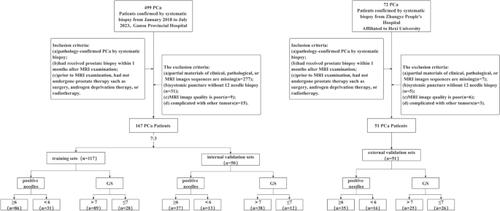Hormones and Cancer ( IF 3 ) Pub Date : 2024-04-16 , DOI: 10.1007/s12672-024-00980-8 Nini Pan , Liuyan Shi , Diliang He , Jianxin Zhao , Lianqiu Xiong , Lili Ma , Jing Li , Kai Ai , Lianping Zhao , Gang Huang

|
Purpose
The Gleason score (GS) and positive needles are crucial aggressive indicators of prostate cancer (PCa). This study aimed to investigate the usefulness of magnetic resonance imaging (MRI) radiomics models in predicting GS and positive needles of systematic biopsy in PCa.
Material and Methods
A total of 218 patients with pathologically proven PCa were retrospectively recruited from 2 centers. Small-field-of-view high-resolution T2-weighted imaging and post-contrast delayed sequences were selected to extract radiomics features. Then, analysis of variance and recursive feature elimination were applied to remove redundant features. Radiomics models for predicting GS and positive needles were constructed based on MRI and various classifiers, including support vector machine, linear discriminant analysis, logistic regression (LR), and LR using the least absolute shrinkage and selection operator. The models were evaluated with the area under the curve (AUC) of the receiver-operating characteristic.
Results
The 11 features were chosen as the primary feature subset for the GS prediction, whereas the 5 features were chosen for positive needle prediction. LR was chosen as classifier to construct the radiomics models. For GS prediction, the AUC of the radiomics models was 0.811, 0.814, and 0.717 in the training, internal validation, and external validation sets, respectively. For positive needle prediction, the AUC was 0.806, 0.811, and 0.791 in the training, internal validation, and external validation sets, respectively.
Conclusions
MRI radiomics models are suitable for predicting GS and positive needles of systematic biopsy in PCa. The models can be used to identify aggressive PCa using a noninvasive, repeatable, and accurate diagnostic method.
中文翻译:

使用磁共振成像放射组学预测前列腺癌侵袭性:一项双中心研究
目的
格里森评分 (GS) 和阳性针是前列腺癌 (PCa) 的重要侵袭性指标。本研究旨在探讨磁共振成像 (MRI) 放射组学模型在预测 PCa 系统活检的 GS 和阳性针中的有用性。
材料与方法
回顾性招募来自 2 个中心的 218 名经病理证实的 PCa 患者。选择小视场高分辨率 T2 加权成像和对比后延迟序列来提取放射组学特征。然后,应用方差分析和递归特征消除来去除冗余特征。基于 MRI 和各种分类器,包括支持向量机、线性判别分析、逻辑回归 (LR) 以及使用最小绝对收缩和选择算子的 LR,构建了预测 GS 和阳性针的放射组学模型。使用接受者操作特征的曲线下面积(AUC)来评估模型。
结果
选择 11 个特征作为 GS 预测的主要特征子集,而选择 5 个特征用于阳性针预测。选择 LR 作为分类器来构建放射组学模型。对于 GS 预测,放射组学模型在训练集、内部验证集和外部验证集中的 AUC 分别为 0.811、0.814 和 0.717。对于阳性针预测,训练集、内部验证集和外部验证集的 AUC 分别为 0.806、0.811 和 0.791。
结论
MRI放射组学模型适用于预测PCa系统活检的GS和阳性针。该模型可用于使用无创、可重复且准确的诊断方法来识别侵袭性前列腺癌。



























 京公网安备 11010802027423号
京公网安备 11010802027423号